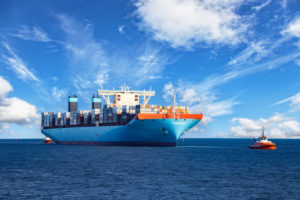
An investigation and comparison of the various energy saving techniques used in the shipping industry has widely varying results for each of the technologies. The industry continues to research and optimize these processes in order to reduce costs, which ultimately reduces the energy footprint, leading to more environmentally acceptable solutions.
The energy footprint for a container shipping vessel is significantly affected by the amount of fuel used during transit. Traditionally, companies have been focused on reducing the duration of the journey, however these models are changing as the freight industry moves towards a more modern philosophy.
In calculating an optimized energy footprint for a freight transiting vessel, consideration needs to be given to the ideal route, weather factors and speed of the vessel. An ideal route will be affected by weather if a vessel detours away from a storm, protecting the vessel and cargo, but most importantly the crew. A prevailing head wind will slow a vessel down unless the ship burns more fuel to meet its schedule. These small factors will have minimal affect on the average energy footprint per journey and become negligible over the vessels lifetime. The greatest factor that will significantly change the energy footprint is the vessel speed.

Container vessel companies adopted a slow speed transit during the financial downturn around 2008/2009 as a measure to save on costs. During this time it became apparent that the customers were willing to accept additional delays if they shared in the savings. Since then, most of the companies have continued these austerity measures, not only to increase their profits but also help meet the environmental regulations of governing bodies. These speed reductions can lead to fuel savings of 30-50 percent and cut CO2 emissions up to 50 percent.
According to a study by the Institute of Maritime Transport and Maritime Management in Antwerp, an average size container ship (4000-5000 TEU) with design speed of 24 knots will burn around 135te of fuel /day. If we reduce this speed to 18 knots (53te/day), even with the extra sailing time we can have the following savings:

For this size vessel, the savings account for nearly half the energy footprint when comparing to maximum ship steaming speeds. This also equates to significant reductions in CO2 emissions.
Other energy saving mechanisms rely on streamlining the vessel and propulsion systems. A hybrid solution with batteries and conventional engine can improve fuel efficiency with up to 15 percent.
Wärtsilä believes the potential for improving energy efficiency is estimated between 30-50 percent, achieving this by optimizing component performance, ship design and waste heat recovery. In 2014 they launched their low loss hybrid system that utilizes different power sources in combination with energy storage devices that contribute annual fuel savings of up to 15 percent, ensuring a substantial reduction in exhaust gas emissions.
Hyundai Heavy Industries have developed a Hi-FIN (Hyundai End-plated Cap Fin) positioned at the base of the propeller (boss cap) to offset the vortex created during propulsion. This will save a vessel up to 2.5 percent of fuel throughout its lifetime.
Currently there are a relatively few cargo ships using LNG for fuel. While many others are expected to follow, transitioning marine engines will be time consuming and costly. Delays are also attributed to a lack of LNG bunkering infrastructure on the more popular Asia/Europe cargo shipping route.
The Mitsubishi Air Lubrication System (MALS) was the first system to deliver energy saving and emission reduction from ships using the innovative technology of Air Lubrication that reduces friction (drag) on the ships hull from the seawater. Although analysis has suggested these types of systems can offer energy savings of up to 10-20 percent, sea trials verified by Lloyds Register have seen efficiency gains closer to 5%. The net gains associated with these are further reduced during inclement weather that produces rougher seas.
Other promising technologies are Rotor Sails and Fuel Oil Emulsion. During dry docking vessels are also remodeling their bulbous bow to improve efficiency.
It is clear that the shipping industry is making a huge effort to maximize energy efficiency during transit in order to meet regulators goals, increase their profit and move into a more socially accepted environmentally conscious and sustainable position.



